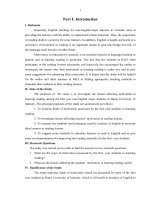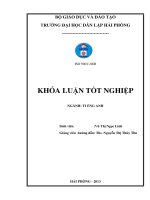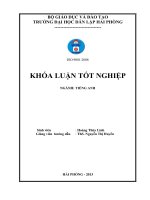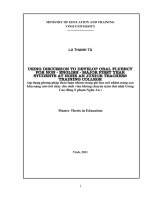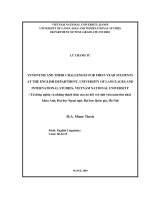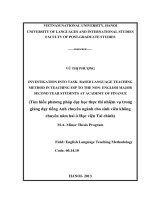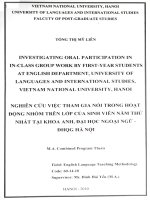Some suggestions for correcting errors made by english non major first year students at HPU of pronouncing ending sounds
Bạn đang xem bản rút gọn của tài liệu. Xem và tải ngay bản đầy đủ của tài liệu tại đây (1.56 MB, 71 trang )
BỘ GIÁO DỤC VÀ ĐÀO TẠO
TRƯỜNG ĐẠI HỌC DÂN LẬP HẢI PHỊNG
-------------------------------
ISO 9001:2008
KHĨA LUẬN TỐT NGHIỆP
NGÀNH: TIẾNG ANH
Sinh viên
Giảng viên hướng dẫn
: Hồng Thùy Linh
: ThS. Nguyễn Thị Huyền
HẢI PHỊNG - 2013
BỘ GIÁO DỤC VÀ ĐÀO TẠO
TRƯỜNG ĐẠI HỌC DÂN LẬP HẢI PHÒNG
-----------------------------------
SOME SUGGESTIONS FOR CORRECTING ERRORS
MADE BY ENGLISH NON-MAJOR FIRST YEAR
STUDENTS AT HPU OF PRONOUNCING ENDING
SOUNDS
KHÓA LUẬN TỐT NGHIỆP ĐẠI HỌC HỆ CHÍNH QUY
NGÀNH: TIẾNG ANH
Sinh viên
: Hồng Thùy Linh
Lớp
: NA 1301
Giảng viên hướng dẫn: ThS. Nguyễn Thị Huyền
HẢI PHÒNG - 2013
BỘ GIÁO DỤC VÀ ĐÀO TẠO
TRƯỜNG ĐẠI HỌC DÂN LẬP HẢI PHỊNG
--------------------------------------
NHIỆM VỤ ĐỀ TÀI TỐT NGHIỆP
Sinh viên: Hồng Thùy Linh
Mã SV: 1357510003
Lớp: NA1301
Ngành: Tiếng Anh
Tên đề tài:
Some suggestions for correcting errors made by English non - major
first year students at HPU of pronouncing ending sounds
NHIỆM VỤ ĐỀ TÀI
1. Nội dung và các yêu cầu cần giải quyết trong nhiệm vụ đề tài tốt
nghiệp
( về lý luận, thực tiễn, các số liệu cần tính tốn và các bản vẽ).
……………………………………………………………………………..
……………………………………………………………………………..
……………………………………………………………………………..
……………………………………………………………………………..
……………………………………………………………………………..
……………………………………………………………………………..
……………………………………………………………………………..
……………………………………………………………………………..
2. Các số liệu cần thiết để thiết kế, tính tốn.
……………………………………………………………………………..
……………………………………………………………………………..
……………………………………………………………………………..
……………………………………………………………………………..
……………………………………………………………………………..
……………………………………………………………………………..
……………………………………………………………………………..
……………………………………………………………………………..
……………………………………………………………………………..
3. Địa điểm thực tập tốt nghiệp.
……………………………………………………………………………..
……………………………………………………………………………..
……………………………………………………………………………..
CÁN BỘ HƯỚNG DẪN ĐỀ TÀI TỐT NGHIỆP
Người hướng dẫn thứ nhất:
Họ và tên:.............................................................................................
Học hàm, học vị:...................................................................................
Cơ quan công tác:.................................................................................
Nội dung hướng dẫn:............................................................................
Người hướng dẫn thứ hai:
Họ và tên:.............................................................................................
Học hàm, học vị:...................................................................................
Cơ quan công tác:.................................................................................
Nội dung hướng dẫn:............................................................................
Đề tài tốt nghiệp được giao ngày 25 tháng 03 năm 2013
Yêu cầu phải hoàn thành xong trước ngày 29 tháng 06 năm 2013
Đã nhận nhiệm vụ ĐTTN
Đã giao nhiệm vụ ĐTTN
Người hướng dẫn
Sinh viên
Hải Phòng, ngày ...... tháng........năm 2013
Hiệu trưởng
GS.TS.NGƯT Trần Hữu Nghị
PHẦN NHẬN XÉT CỦA CÁN BỘ HƯỚNG DẪN
1. Tinh thần thái độ của sinh viên trong quá trình làm đề tài tốt
nghiệp:
……………………………………………………………………………..
……………………………………………………………………………..
……………………………………………………………………………..
……………………………………………………………………………..
……………………………………………………………………………..
……………………………………………………………………………..
……………………………………………………………………………..
2. Đánh giá chất lượng của khóa luận (so với nội dung yêu cầu đã đề ra
trong nhiệm vụ Đ.T. T.N trên các mặt lý luận, thực tiễn, tính toán số
liệu…):
……………………………………………………………………………..
……………………………………………………………………………..
……………………………………………………………………………..
……………………………………………………………………………..
……………………………………………………………………………..
……………………………………………………………………………..
……………………………………………………………………………..
……………………………………………………………………………..
……………………………………………………………………………..
3. Cho điểm của cán bộ hướng dẫn (ghi bằng cả số và chữ):
……………………………………………………………………………..
……………………………………………………………………………..
……………………………………………………………………………..
Hải Phòng, ngày … tháng … năm 2013
Cán bộ hướng dẫn
(Ký và ghi rõ họ tên)
NHẬN XÉT ĐÁNH GIÁ
CỦA NGƯỜI CHẤM PHẢN BIỆN ĐỀ TÀI TỐT NGHIỆP
1. Đánh giá chất lượng đề tài tốt nghiệp về các mặt thu thập và phân tích
tài liệu, số liệu ban đầu, giá trị lí luận và thực tiễn của đề tài.
.................................................................................................................................
.................................................................................................................................
.................................................................................................................................
.................................................................................................................................
.................................................................................................................................
.................................................................................................................................
.................................................................................................................................
.................................................................................................................................
.................................................................................................................................
2. Cho điểm của người chấm phản biện : ………………………..
(Điểm ghi bằng số và chữ)
Ngày.......... tháng......... năm
2013
Người chấm phản biện
ACKNOWLEDGEMENTS
I would like to express my gratitude to all those who gave me the possibility,
support and helpful advice to complete this graduation paper.
First of all, I want to thank my instructor, Ms Nguyen Thi Huyen from
Foreign Language Department at HPU for guiding me how to do the research
in the effective way. Her guidance helped me in all the time of research and
writing of this thesis.
Besides my instructor, I want to thank Ms Dang Thu Hien who gave me a lot
of helpful advice during the time of researching.
I would like to express my sincere gratitude to Miss Nguyen Quynh Hoa from
Foreign Language Department for her help and encouragement.
My sincere thank also goes to Ms Tran Ngoc Lien, Dean of Foreign Language
Department for her permission to take part in her classes to give survey
questionnaire to students.
I also want to thank all the members of NA1301. They were always stand by
me when I felt down and helped me feel better, gave me motivation to
complete this graduation paper.
Last but not least, I would like to thank my family, my mother for giving birth
to me and supporting me spiritually throughout my life.
TABLE OF CONTENTS
ACKNOWLEDGEMENTS.......................................................................................
CHAPTER 1: INTRODUCTION ...................................................................... 1
1. Rationale............................................................................................................ 1
2. Aims of the study .............................................................................................. 2
3. Research methods.............................................................................................. 2
4. Scope of the study ............................................................................................. 3
5. Significance of the study ................................................................................... 3
CHAPTER 2: THEORETICAL BACKGROUND ......................................... 4
2.1. English pronunciation .................................................................................... 4
2.1.1. What is pronunciation?............................................................................ 4
2.1.2. The importance of English pronunciation ............................................... 5
2.2. English sounds ............................................................................................... 6
2.2.1. Vowel sounds .......................................................................................... 6
2.2.1.1. Definition ............................................................................................. 6
2.2.1.2. Classification and Description of vowels............................................. 6
2.2.2. Consonant sounds .................................................................................... 9
2.2.2.1. Definition ............................................................................................. 9
2.2.2.2. Classification and Description of consonants ...................................... 9
2.3. English ending sounds.................................................................................. 13
2.3.1. Definition............................................................................................... 13
2.4. Pronunciation errors ................................................................................. 15
2.4.1. What is pronunciation error? ................................................................. 15
2.4.2. Ending sounds errors ............................................................................. 16
2.5. Existing studies on some common mistakes about final consonants that
English learners in Vietnam tend to make .......................................................... 17
CHAPTER 3: FINDINGS AND DISCUSSION ............................................. 19
3.1. Survey questionnaires .................................................................................. 19
3.1.1. Participants ........................................................................................... 19
3.1.2. Purposes of the survey questionnaires ................................................. 19
3.1.3. Design of the survey questionnaires .................................................... 20
3.1.4. Data collection instrument ................................................................... 20
3.1.5. Data analysis procedure ....................................................................... 21
3.2. Data analysis ................................................................................................ 21
3.2.1. Students’ attitudes toward English ending sound pronunciation ........ 21
3.2.1.1. Students’ attitude toward English pronunciation .............................. 21
3.2.1.2. Students’ frequency of pronouncing ending sounds ......................... 22
3.2.1.3. Problems related to ending sounds faced by English non-major
first year students at HPU .............................................................................. 23
3.2.1.4. Students’ perceptions about reasons for their difficulties related to
ending sounds ................................................................................................. 27
3.2.2. Teachers’ techniques in teaching pronunciation in class ..................... 28
3.2.3. Students’ expectations toward teachers in pronunciation class ........... 29
3.2.3.1. Students’ preferred techniques by teachers in pronunciation class .. 29
3.2.3.2. Students’ expectations toward teachers in class ............................... 31
3.3. Discussion .................................................................................................... 31
CHAPTER 4: SUGGESTIONS FOR STUDENTS TO CORRECT
ENDING SOUNDS ERRORS .......................................................................... 33
4.1. Suggested tips to 5 common ending sounds errors /ð/, /θ/, /tʃ/, /dʒ/, /ʃ/ ..... 33
4.2. Suggested techniques for students to correct ending sounds errors ............ 35
4.2.1. Games ................................................................................................... 35
4.2.1.1. Odd one out ....................................................................................... 35
4.2.1.2. IPA Bingo ......................................................................................... 36
4.2.1.3. Minimal Pair Slap ............................................................................. 37
4.2.1.4. Crazy ed- cards ................................................................................. 37
4.2.1.5. Crazy s- cards .................................................................................... 38
4.2.1.6. Number dictation .............................................................................. 39
4.2.1.7. Tongue twister .................................................................................. 39
4.2.1.8. The Restaurant Menu ........................................................................ 40
4.2.1.9. Large – Group Interviews ................................................................. 42
4.2.1.10. The Memory Game ......................................................................... 43
4.2.2. Training your ears by listening to music................................................... 44
4.2.3. Recording yourself .................................................................................... 46
4.2.4. Reading pronunciation books.................................................................... 47
4.2.5. Watching pronunciation videos on Youtube............................................. 48
4.2.6. Pronouncing the consonants only ............................................................. 50
4.2.7. Practicing in front of the mirror ................................................................ 50
4.2.8. Monitoring................................................................................................. 51
4.3. Exercises for practicing ending sounds........................................................ 51
4.3.1. Odd one out exercise ............................................................................ 51
4.3.2. Circle the words ending with /dʒ/ ........................................................ 53
4.3.3. Practicing ending sounds with minimal pair final /t/ and /d/ ............... 53
4.4. Conclusion.................................................................................................... 53
APPENDICE ...........................................................................................................
APPENDIX 1 ...........................................................................................................
APPENDIX 2 ...........................................................................................................
REFERENCES ........................................................................................................
CHAPTER 1: INTRODUCTION
1. Rationale
In recent years, English has become one of the most popular languages in all
over the world and in Vietnam as well. Besides, English plays an important
role in the period of intergration. Thus, it has become a second language in
Vietnam. Of the four basic skills in English, speaking seems to be paid great
attention by ESL learners. Nevertheless, there is a large percentage of
Vietnamese people who speak English making mistakes with pronunciation.
While learning English, there are a number of problems relating to
pronunciation errors that ESL learners tend to make: intonation, word,
sentence stress, especially ending sounds. However, Vietnamese students who
study English have their own problems. In order to study these problem in
depth, this research will go into details of pronunciation errors concerning
ending sounds of English non-major 1st year students at Haiphong Private
University.
As can be seen, if ESL learners want to speak English correctly and fluently,
it is necessary to pay attention to ending sounds. Vietnamese is a kind of
language which has single words with no ending sounds while these sounds
play a very important role in English. It is particularly difficult for native
English to identify the words being spoken without pronouncing ending
sounds. As a matter of fact, ending sounds errors are very typical and popular
to Vietnamese students, especially English non-major 1st year students at
Haiphong Private University. Therefore, it was a motivation for the author of
the reasons to discuss. Hopefully, this study will help students grow
awareness of problems that they might have not noticed before and raise some
suggestions to correct errors.
1
2. Aims of the study
The purpose of this research is to help English non-major 1st year students at
Haiphong Private University realize mistakes when pronouncing ending
sounds. Besides, it will help them raise awareness of their pronunciation
problems. Moreover, this research also aims to help these students improve
speaking skill and ending sounds pronunciation. This study will focus on two
issues. The first one is to find out the ending sounds errors of English nonmajor first year students at HPU. The second one is to give out the
suggestions for students to correct these errors. Here are the two research
questions of the study:
Research questions:
1) What are the ending sound errors that English non-major 1st year
students at Haiphong Private University are likely to make?
2) What can the students do to improve English pronunciation, especially
ending sounds?
3. Research methods
To achieve the above mentioned aims, the study employs the following
methods of study:
Firstly, reference book and previous researches related to ending sounds are
review to get background knowledge of English pronunciation, ending
sounds.
Secondly, a survey is conducted for two Toeic level 1 classes at HPU with a
view to finding out their problems, evaluations of the matter and the
difficulties that they have as well as the expectations towards pronunciation.
Last but not least, all the necessary information needed for the findings of the
survey will be collected through the observation and interview with students.
2
4. Scope of the study
In English, there are many problems related to pronunciation errors. However,
this study does not aim to cover all problems with pronunciation errors of the
ESL learners. Within the time limitation, the research just focuses on five
common ending sounds errors of 60 English non-major first year students at
Haiphong Private University, that is, /ð/, /θ/, /tʃ/, /dʒ/, /ʃ/.
5. Significance of the study
It is undeniable that English is one of the most important subjects in all
school. At Haiphong Private University, all students from different
departments have to learn English and they have to pass the Toeic exam at the
end of the semester. It can be clearly seen that, four skills in learning English
are also important but the most important one must be speaking skill.
However, this is the skill that students often afraid of. To English non-major
first year students at Haiphong Private University, their speaking skill seems
to be pretty bad, especially in pronouncing ending sounds. The thesis is
intended to point out the ending sounds errors that students tend to make and
the solutions to solve the problems. The research is a useful reference for
students to learn English pronunciation and correct ending sounds errors.
Consequently, chapter 1 has dealt with the content of the study. Rationale,
aims, research methods and questions, scope and significance of the study
were gave out to introduce and to be a basis for analysis in the next parts. In
chapter 2, the theoretical background of pronunciation, ending sounds errors,
previous studies…will be thoroughly presented.
3
CHAPTER 2: THEORETICAL BACKGROUND
Theoretical background provides readers with the relevant literature of the
study by introducing some key concepts necessary for the best understanding
of this research. This chapter explains various aspects related to the topic of
pronunciation, especially ending sounds. It is started with a brief description
of pronunciation and its importance, general knowledge about English
sounds, English ending sounds and then show some previous studies on some
common mistakes about final consonants that English learners in Vietnam
tend to make.
2.1. English pronunciation
2.1.1. What is pronunciation?
Pronunciation is one of the subjects in English that each student has to learn at
least one time. There are a lot of definitions of pronunciation and each one is
different from each other.
First of all, according to definition in Oxford Dictionaries, pronunciation was
defined as: the way in which a word is pronounced. Besides, pronunciation
was also put as “the way in which a language is spoken” (Oxford Advance
Learner’s Encyclopedic, 1992:718). The Oxford Advanced Learner’s
Dictionary, 8th ed (2008) makes clear pronunciation is “the way in which a
language or a particular word or sound pronounced”.
According to Wikipedia Dictionaries, there was another definition of
pronunciation: “Pronunciation refers to the ability to use the correct stress,
rhythm, and intonation of a word in a spoken language. A word can be spoken
in different ways by various individuals or groups, depending on many
factors, such as: the area in which they grew up, the area in which they now
live, if they have a speech or voice disorder, their ethnic group, their social
class, or their education.”
4
In the AMEP Fact sheets that have been funded by the Department of
Immigration and Multicultural and Indigenous Affairs through the AMEP
Special Project Research Program, pronunciation was defined as: “The
production of sounds that we use to make meaning. It includes attention to the
particular sounds of a language (segments), aspects of speech beyond the
level of the individual sound, such as intonation, phrasing, stress, timing,
rhythm (suprasegmental aspects), how the voice is projected (voice quality)
and, in its broadest definition, attention to gestures and expressions that are
closely related to the way we speak a language. Each of these aspects of
pronunciation is briefly outlined below, and references for further study are
suggested.”
2.1.2. The importance of English pronunciation
In order to speak English correctly and fluently, pronunciation should be paid
attention to. It plays an important role in speaking English. Many non-native
speakers have studied grammar for many years but are unable to speak like
native speakers due to their inability to pronounce the sounds of words
properly. Many cases of misunderstanding in communication were caused by
the mispronouncing of words or the improper intonation. According to the
AMEP Fact sheets, learners with good pronunciation in English are more
likely to be understood even if they make errors in other areas, whereas
learners whose pronunciation is difficult to understand will not be understood,
even if their grammar is perfect. Many adult learners find pronunciation one
of the most difficult aspects of English to acquire, and need explicit help from
the teacher (Morley 1994; Fraser 2000).
5
2.2. English sounds
2.2.1.
Vowel sounds
2.2.1.1.
Definition
In phonetics, a vowel is a sound in spoken language, such as English “ah!”
[a:], pronounced with an open vocal tract so that there is no build-up of air
pressure at any point above the glottis. According to Roach (2000:10), vowels
are “sounds in the production of which there is no obstruction to the flow of
air as it passes from the larynx to the lips”.
Vowel is a major sound in a word, which part brings senses.
In a word, just only vowel link together can make a meaning word, but if
lacking vowels (semivowels), those word have no meaning.
According to English phonetics and phonology, vowel was defined as
below:“ Vowel is a speech sound in which the air stream from the lung is not
blocked in any way in the mouth or throat and which is usually pronounced
with the vibration of the vocal cords.”
2.2.1.2. Classification and Description of Vowels:
Monophthongs
According to the length of the sounds:
Short vowels:
/i/
/e/
/ʌ /
Long vowels:
/i:/
/ ɔ/
/æ/
/ ʊ/
/u:/
/ə/
/ɜ:/
/ɔ/
/a:/
According to the height of the tongue body in the mouth:
High vowels: The tongue is high in the mouth.
/ i, i: , ʊ, u: /
Mid vowels: The tongue neither high nor low in the mouth.
/ e, ɔ: , ə, ɜ:/
6
Low vowels: The tongue below its rest position.
/ æ, ʌ , ɔ , a:/
According to front / back position of the tongue.
Front vowels: The front of the tongue is raised.
/ i, e, æ, i: /
Central vowels: Neither the front nor the back of the tongue is raised.
/ ə, ɜ: , ʌ /
Back vowels: The back of the tongue is raised.
/ u: , ʊ , ɔ , a: , ɔ: /
According to the degree of lip rounding.
Rounded vowels: The corner of the lips are brought towards each other and
the lips pushed forwards.
/u: , ʊ , ɔ , ɔ: /
Spread: The corners of the lips moved away from each other as for a smile.
/ i, e, æ , i: /
Neutral: The lips neither sounded nor spread.
/ ə , ɜ: , ʌ , a: /
Hereunder is the vowel chart:
Figure 1: English Vowel (IPA chart)
7
Diphthongs
A diphthong , literally "two sounds" or "two tones", also known as a gliding
vowel, refers to two adjacent vowel sounds occurring within the
same syllable. Technically, a diphthong is a vowel with two different targets:
that is, the tongue moves during the pronunciation of the vowel. For most
dialects of English, the phrase "no highway cowboys" contains five distinct
diphthongs. There are 2 types of diphthongs: closing and centering
diphthongs.
Closing diphthongs:
Three ending in ‘ɪ’: eɪ, aɪ, ɔɪ
Two ending in ‘ʊ’: əʊ, aʊ
Example:
eɪ: paid, pain, face, shade, age, wait, taste, paper
aɪ: tide, time, nice, buy, bike, pie, eye, kite, fine
ɔɪ: void, loin, voice, oil, boil, coin, toy, Roy
əʊ: load, home, most, bone, phone, boat, bowl
aʊ: loud, gown, house, cow, bow, brow, grouse
Centering diphthongs:
Three ending in ‘ə’ : ɪə, eə, ʊə
Example:
ɪə : beard, weird, fierce, ear, beer, tear
eə
: aired, cairn, scarce, bear, hair,
ʊə
:
moored, tour, lure, sure, pure
8
2.2.2.
Consonant sounds
2.2.2.1. Definition
According to the Oxford Advanced Learner’s Encyclopedic (1992:192),
consonants are “speech sounds made by completely or partly stopping the
flow of air breathed out through the mouth”. In Wikipedia Dictionary, it is
said that “the number of consonants in the world’s languages is much greater
than the number of consonant letters in any one alphabet”. In English
phonetics and phonology (Roach, 2000:10), the term consonant can be
defined as “sounds in which there is obstruction to the flow of air as it passes
the larynx to the lips”. One more collected definition from the lectures: The
production of sounds, consonant was defined as: “Consonant sounds are the
sounds, in the production of which one articulator moves towards another or
two articulators come together obstructing the air stream and the air stream
can’t get out freely.”
2.2.2.2. Classification and description of consonants
According to Marianne, Donna and Janet (1996:42,43), the consonants system
was classified according to place and manner of articulation. Here are
classification and description of consonants according to place of articulation.
According to the slide share by Hai Ha Do (Feb, 2013), place of articulation
was defined as “the location of the obstruction of the air stream in the
articulation of consonants. It describes the point at which the articulators
actually touch or at their closest.” Hereunder are the description of
consonants according to place of articulation:
Bilabials: are the sounds made with the two lips pressed together or coming
together. /b, p, w, m/
Labio-dentals: are the sounds which are produced with the lower lip touching
the upper front teeth. /f, v/
9
Dentals: are the sounds which are produced with the tip or blade of the tongue
touching the upper front teeth. / θ, ð/
Alveolars: are the sounds which are produced with the tip or blade of the
tongue touching or approaching the alveolar ridge. /t, d, s, z, n, l/
Retroflex: is the sound which is produced with the tip of the tongue curling
back towards the back of the alveolar ridge. /r/
Palato - alveolars: are the sounds which are produced with the tongue tip or
blade coming close to the area between the back of the alveolar ridge and the
front of the hard palate. /ʃ, ʒ, tʃ , dʒ/
Palatal: is the sound which is produced with the front of the tongue coming
close to the hard palate. /j/
Velars: are the sounds which are produced with the back of the tongue
touching the soft palate. /k, g, ŋ/
Glottal: are the sounds which are produced without the active use of the
tongue and other parts of the mouth. /h/
Figure 2: Place of articulation(Amber N:2009)
10
As can be seen from the above figure, the place of articulation has clearly
shown, so what about the manner of articulation? According to Do (2013),
manner of articulation is “the way in which the air stream is obstructed in the
production of speech sounds. It describes the type of obstruction which is
caused by the narrowing or closer of the articulators.” Hereunder are the
description of consonants according to manner of articulation:
Nasals: they are produced with the air- stream being stopped in the oral
cavity but the soft palate is down so that the air can go out through the nose.
/m, n, ŋ/
Plosives: are the sounds which are produced with the air-stream being
stopped in the oral cavity and the soft palate is raised blocking off the nasal
cavity. Then the two articulators come apart quickly and the air escapes
through the oral tract. /p, b, t, d, k, g/
Fricatives: are the sounds in the production of which two articulators come
close together but there is still a small opening between them so the airstream is partially obstructed and an audible friction noise is produced. /f, v,
ʃ, ʒ, θ, ð, s, z, h/
Affricates: are the sounds which are produced when a stop is immediately
followed by a fricative. / tʃ , dʒ/
Lateral: is the sound which is made when the air-stream is obstructed at a
point along the centre of the oral tract, with incomplete closure between one
or both sides of the tongue and the roof of the mouth. / l /
Approximants: are the sounds in the production of which two articulators
come close together but without the vocal tract being narrowed to such an
extent that a friction noise is produced. /r, w, j/
11
Figure 3: Articulators (Cox, Mannell: 2011)
Clearly, figure 2 and 3 have shown both the place and manner of articulation
in determining what sound is produced. This information will be summarized
in table below:
12
Figure 4: Table of consonants sounds (Viernes:2012)
2.3.
English ending sounds
2.3.1. Definition
To ESL learners, the term “ending sound” is very popular while learning
English. To understand easily, “ending sounds” are sounds that occur at the
end of the word. It refers to the consonant sounds as the word can end with
one or more consonant sounds (consonant clusters). Ending sounds are called
Codas: “The coda is the final consonant or consonant cluster.” (Barbara and
Brian, 1997). According to Rachael-Anne Knight, 2003, University of Surrey
– Roehampton (Understanding English Variation, Week 3), there can be up to
4 consonants in a coda:
If there are no consonants at the end of the word, it has a zero coda.
A single consonant is called the final consonant. Any consonant except h, r, w
and j may be a final coda.
Example: Final consonant sounds in English are listed as below:
13
/p/ - keep, sleep
/ʃ/ - crash
/b/ - rib, nib
/tʃ/- teach
/t/ - right, start
/dʒ/- bridge
/d/ - ride
/k/ - pick, kick
/m/- lamb
/f/ - leaf
/n/ - than, man
/v/ - leave
/ŋ/ - sing, spring
/θ/ - earth
/l/ - pool, smile
/ð/ - breathe
/ʒ/ - message, massage
/s/ - this
/g/ - beg, keg
/z/ - these, has
When there are two or more consonants standing at the end of the word,
the terms “pre-final” and “post-final” consonants are used.
Pre-final includes: /m/, /n/, /ŋ/, /l/, /s/
Post-final includes: /s/, /z/, /t/, /d/, /θ/
Two consonant clusters:
Pre-final m, n, ŋ, l, s followed by a final consonant
Consonant plus post-final s, z, t, d, θ
Example: help, bank, books, blind etc.
Three consonant clusters:
Pre-final plus final plus post-final (e.g. helped, banks, bonds)
Final plus post-final plus post final s, z, t, d, θ (e.g. fifths, next)
Four consonant clusters:
Most are pre-final plus final plus post-final (e.g. twelfths, prompts)
Occasionally there is one final and three post final consonants (e.g. sixths,
texts..)
14
